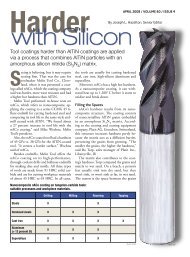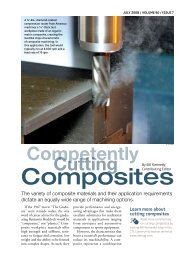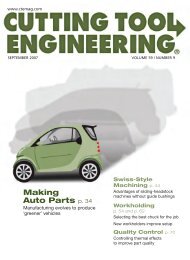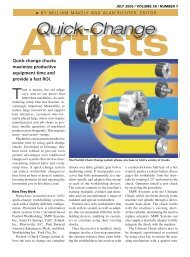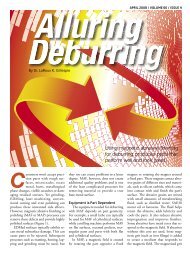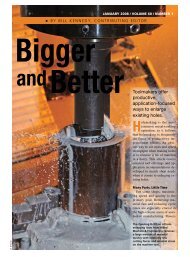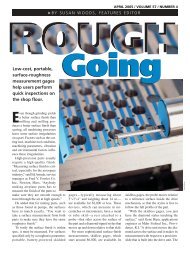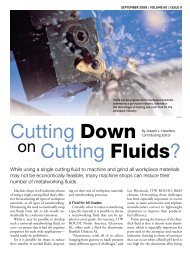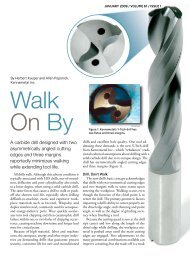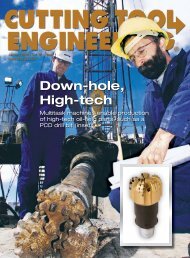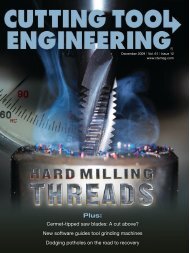June 2008 / volume 60 / issue 6 - Cutting Tool Engineering
June 2008 / volume 60 / issue 6 - Cutting Tool Engineering
June 2008 / volume 60 / issue 6 - Cutting Tool Engineering
Create successful ePaper yourself
Turn your PDF publications into a flip-book with our unique Google optimized e-Paper software.
JUNE <strong>2008</strong> / VOLUME <strong>60</strong> / ISSUE 6<br />
By Bill Kennedy,<br />
Contributing Editor<br />
Chopper<br />
Shop<br />
A small, Philadelphiaarea<br />
shop is using a<br />
55,000-psi, 2,000-mph<br />
abrasive waterjet<br />
to help grow its primary<br />
business: making parts<br />
for Boeing aircraft.<br />
Small companies are still an engine<br />
of growth for the U.S.<br />
economy, and one of the ways<br />
they can grow is by employing<br />
innovative ideas and new technologies.<br />
A good example of this process is<br />
Davidson Fabricating Inc., a family-run<br />
sheet metal shop. It has grown from 12<br />
to 30 employees over the last 6 years, in<br />
part by installing an abrasive waterjet<br />
machine. Also, the shop is adding another<br />
AWJ machine to help it handle<br />
growing demand.<br />
James Davidson Sr. founded Davidson<br />
Fabricating in Broomall, Pa., in<br />
B. Kennedy and Boeing (bottom)<br />
At Davidson Fabricating, an abrasive waterjet cuts 18"×15" plates from 0.050"-thick 7075<br />
aluminum and pierces 27 0.098"-dia. holes. Davidson Fabricating uses AWJ technology<br />
to cut aluminum parts for the Chinook helicopter, Boeing’s longest-running aircraft<br />
production program.<br />
1963. His son, Jim, is now owner and<br />
president of the company. Jim oversees<br />
all operations, while General Manager<br />
Colleen Hurst and Shop Foreman Jamie<br />
Davidson, Jim’s son, handle day-to-day<br />
activities.<br />
Davidson Fabricating serves a variety<br />
of customers, but most of its work<br />
involves cutting parts and fabricating<br />
assemblies for aircraft maker Boeing<br />
Co. Most are aluminum components<br />
Learn more about<br />
waterjet cutting<br />
Read more commentary on<br />
waterjet cutting by visiting Bill<br />
Kennedy’s blog in the CTE Community<br />
section online at www.ctemag.com.<br />
for the venerable Chinook helicopter,<br />
Boeing’s longest-running aircraft production<br />
program, and the new V-22
Osprey twin-rotor aircraft. The Osprey’s<br />
first combat-zone deployment was in<br />
Iraq in October 2007.<br />
Most of Davidson’s parts range in<br />
size from inches to feet. Assemblies are<br />
generally 1' or 2' square. Production<br />
<strong>volume</strong>s range from single-digit to hundreds,<br />
“depending on how many aircraft<br />
they are building,” said Jamie Davidson.<br />
Chinook orders include replacement<br />
parts and parts for new models. New<br />
part orders for the Osprey are rising as<br />
production ramps up.<br />
Boeing has grown in significance as<br />
a Davidson customer since the mid-<br />
1990s. At that time, Davidson cut aluminum<br />
sheet with bandsaws or shears<br />
and blanked holes with a Weidemann<br />
CNC turret punch press. To meet increased<br />
demand, Davidson sought alternative<br />
ways to cut sheet metal in 2000.<br />
Customer requirements immediately<br />
ruled out laser and plasma cutters because<br />
both create a heat-affected zone<br />
Davidson Fabricating<br />
has grown from 12 to<br />
30 employees over the<br />
last 6 years, in part by<br />
installing an abrasive<br />
waterjet machine. Also,<br />
the shop is adding<br />
another AWJ machine to<br />
help it handle growing<br />
demand.<br />
at the site of the cut and the high temperatures<br />
generated can alter the metal<br />
temper condition.<br />
AWJ technology provided the solution.<br />
In 2003, Davidson consulted with<br />
Romeo <strong>Engineering</strong> Inc., Fort Worth,<br />
Texas, a manufacturer of waterjet cutting<br />
systems, composite-fabricating machines<br />
and automation systems, and<br />
bought a Romeo Silver unit consisting<br />
of a 6'×12' table and a PC-based CNC.<br />
The machine features a high-pressure<br />
system from KMT Waterjet Systems<br />
(then Ingersoll-Rand Waterjet), Baxter<br />
Springs, Kan. The system has a 30-hp<br />
motor driving a hydraulic pump that,
B. Kennedy<br />
Operator Malcolm Robinson positions weights on a sheet of 0.050"-thick 7075 aluminum<br />
to assure it doesn’t move while being cut with an AWJ.<br />
through an intensifier, produces 55,000<br />
psi of water pressure.<br />
Jamie Davidson estimated that 90<br />
percent of the shop’s work is processed<br />
in the AWJ at some point in production,<br />
including 500 different part numbers<br />
for the V-22 and <strong>60</strong>0 part numbers<br />
for the Chinook helicopter.<br />
A Part’s Progress<br />
Robert Lee, offload coordinator/programmer<br />
for Davidson,<br />
outlined the steps in producing<br />
parts on the AWJ.<br />
If a customer’s part<br />
drawing includes<br />
a large number of<br />
features, such as<br />
holes and complex edge geometry,<br />
Lee redraws it in Pro/Engineer<br />
CAD drafting software before loading it<br />
into the fabrication CAM software from<br />
Shop Data Systems. “If it’s a pretty simple<br />
part, I’ll just enter the data [directly<br />
into the CAM software] from scratch,”<br />
said Lee, “because sheet metal cutting<br />
involves just X and Y dimensions.”<br />
Next, from a menu of material types<br />
and thicknesses, Lee selects the workpiece<br />
material for the part and the software<br />
sets the initial cutting speed. He<br />
noted that although cutting parameters<br />
will vary significantly from one material<br />
to another, such as aluminum to steel,<br />
differences within one material group<br />
generally are small. In aluminum, for<br />
example, the different hardnesses between<br />
a T-6 temper condition and a “0”<br />
(annealed alloy) “might affect cutting<br />
speeds only a little bit,” he said.<br />
Davidson has found that the most<br />
effective way of transferring the CAM<br />
program from Lee’s office to the AWJ<br />
machine is manually carrying a floppy<br />
disk. Wireless intranet data transfer was<br />
attempted, but welding near the AWJ<br />
B. Kennedy<br />
Davidson Fabricating employs an abrasive<br />
waterjet to cut these 3½"×1"×0.100"-thick<br />
7075-T73 aluminum components and pierce<br />
their four 0.098"-dia. holes for the V-22<br />
Osprey twin rotor aircraft.<br />
interfered with the wireless signal.<br />
At the machine, operator Malcolm<br />
Robinson loads the floppy disk and<br />
starts the operation. On a new job, the<br />
standard procedure is to cut one piece<br />
and then send it to inspection to confirm<br />
its accuracy. “If Malcolm sends a<br />
part to inspection and a hole is not as<br />
circular as it should be, then you know<br />
you need to change something,” Lee<br />
said.<br />
Working with the thin sheet metal<br />
used in the parts Davidson manufactures<br />
means “You can’t just turn the
machine on and walk away,” said Robinson.<br />
“The material may pop up; you<br />
have to keep an eye on it.” He often<br />
uses short steel cylinders as weights and<br />
moves them around during the cutting<br />
operation to maximize the aluminum<br />
sheet’s stability and flatness. One reason<br />
to minimize workpiece warping, Robinson<br />
said, is that the distance between<br />
the cutting tip and the work determines<br />
the size of the cut or hole and needs to<br />
be maintained at about 1 ⁄8".<br />
Jamie Davidson described another<br />
way to stabilize thin workpieces. “If it’s<br />
real thin material—0.012" or 0.015"<br />
thick—you can stack a couple sheets<br />
of the material together, then put a<br />
masonite board on top and bottom so<br />
you are actually cutting through the<br />
masonite and through the sheets at the<br />
same time.” The method also provides<br />
more parts per operation.<br />
Although the CAM software sets<br />
the operation’s basic cutting speed, the<br />
Romeo machine features a hand-held<br />
pendant control that enables the operator<br />
to vary the cutting speed for special<br />
conditions, such as slowing the rate for<br />
tight part geometries. The rate of abrasive<br />
flow is variable as well. Both speed<br />
Paul Oehler, vice President<br />
for CNC systems, Romeo <strong>Engineering</strong>,<br />
outlined the economic considerations<br />
of a shop like Davidson Fabricating that<br />
uses an X-Y table to cut flat parts. He<br />
presented general assumptions that<br />
waterjets in that class typically cost $23<br />
to $25 per hour to operate, and added<br />
to that $10 an hour for an operator to<br />
load and unload parts. “You don’t want<br />
somebody programming at the machine,”<br />
he said. “The machine makes money when<br />
it’s making noise. Throughput is really<br />
important.”<br />
“If a shop charges $135 per hour<br />
for waterjet services and their direct<br />
cost is $35 per hour for the operator,<br />
maintenance, electricity and consumables,<br />
the AWJ will produce a return of $100<br />
per hour,” Oehler said. Considering a<br />
typical finance payment on the machine<br />
of $2,500 per month, “as long as they can<br />
run the machine for 25 hours a month,<br />
it’s paying for itself in a week’s worth of<br />
and abrasive flow rate may need to be<br />
adjusted in thicker materials to avoid a<br />
tapered cut—where the kerf is larger at<br />
the top than at the bottom of the part.<br />
Lee said Davidson’s production<br />
schedule is customer-driven; at regular<br />
intervals he reviews the pending jobs<br />
and rearranges their order to reflect<br />
demand. As this article was being written,<br />
Davidson was taking delivery of<br />
a new 5'×10' Romeo table, equipped<br />
with a KMT Streamline SL-V 30 pump<br />
system. Jamie Davidson said in addition<br />
to adding cutting capacity, the smaller<br />
unit will speed the processing of smaller<br />
parts because the operator can handle<br />
smaller sheets of aluminum more<br />
efficiently.<br />
AWJ Basics<br />
Waterjet cutting technology was<br />
introduced in the early 1970s, when<br />
high-pressure (50,000 psi), 0.005"-dia.<br />
streams of water were first employed<br />
to cut soft materials, such as cardboard<br />
and food products. In the early 1980s,<br />
a stream of abrasive grains was added<br />
to the high-pressure jets, making them<br />
capable of cutting hard materials, such<br />
as Inconel and ceramics, as well as work-<br />
The economics of abrasive waterjet cutting<br />
run time. So the other three weeks of the<br />
month, as long as they hustle up and keep<br />
the machine making noise, can be very<br />
profitable,” he said.<br />
For a job shop processing a variety<br />
of parts, scheduling is the way to gain<br />
maximum return on investment. “You<br />
want to have the operator loading and<br />
unloading metal, plastics, stone, anything<br />
that is going to cut very quickly in the<br />
mornings and the afternoons,” Oehler said.<br />
Heavy materials such as 2"-, 4"- and 6"thick<br />
plate should run unattended<br />
at night.<br />
No operator is needed during the<br />
long cutting cycles, and machine<br />
monitoring systems assure that<br />
operations will halt if a problem occurs.<br />
Use of long-lived AWJ components,<br />
such as diamond orifices, also contribute<br />
to reliability. “When you come in the next<br />
morning, there is a tank full of parts,”<br />
Oehler said.<br />
—B. Kennedy
B. Kennedy<br />
This two-stage intensifier Streamline SLV 30 pump from KMT Waterjet Systems produces<br />
55,000 psi of cutting pressure via two pumping steps: a motor-driven pump generates an<br />
alternating flow of hydraulic fluid to the intensifier (the silver cylinder) in which a singlepiston<br />
reciprocating plunger maintains the high pressure.<br />
pieces up to 10" thick.<br />
Development of worktables and<br />
CNCs that permitted accurate workpiece<br />
fixturing and precise cutting head<br />
motion created a practical tool with<br />
many applications. Today, AWJs cut materials<br />
ranging from wood, marble and<br />
stone to titanium and leather. Three-, 4and<br />
5-axis systems use CNC technology<br />
to cut complex part contours and 3-D<br />
shapes. Machines with multiple cutting<br />
heads boost throughput.<br />
Single-stage direct-drive pumps or<br />
two-stage intensifier setups generate<br />
the high-pressure waterjet. Single-stage<br />
or piston pumps are configured like<br />
auto engines, with multiple pistons<br />
connected to a crankshaft. While they<br />
are energy efficient, pump pressure is<br />
directly dependent on water flow, which<br />
limits the use of multiple cutting heads.<br />
Two-stage intensifier systems involve<br />
two pumping steps; a motor-driven<br />
pump generates an alternating flow of<br />
hydraulic fluid to an intensifier with a<br />
single-piston, reciprocating plunger that<br />
maintains the desired pressure. Because<br />
an intensifier produces a constant level<br />
of pressure independent of flow <strong>volume</strong>,<br />
it can service multiple cutting heads.<br />
The high-pressure water travels into<br />
a cutting head, into a plug called a<br />
jewel, made from ruby, sapphire or diamond,<br />
and through the jewel’s 0.005"-<br />
B. Kennedy<br />
Jamie Davidson, Davidson Fabricating shop<br />
foreman.<br />
to 0.030"-dia. orifice. The tiny opening<br />
produces jet speeds as high as 2,000<br />
mph. The most common orifice material<br />
is sapphire; jewels cost $15 to $30<br />
each and provide 50 to 100 hours of<br />
cutting life. Diamond orifices last 15<br />
to 20 times longer than sapphire jewels,<br />
but cost 10 to 20 times more.<br />
Abrasive grit, usually garnet, is pulled<br />
into the jet just below the jewel. The<br />
grit is produced in different sizes; finer<br />
DEBURR<br />
cross-holes with<br />
ORBITOOL ®<br />
• Manual, CNC or Screw machine<br />
• Shorter cycle times<br />
• Consistent results and quality<br />
• No secondary burr or surface<br />
scratched<br />
• Many sizes down to 1mm<br />
diameter<br />
• Used by Ford Motor Co., BMW,<br />
Robert Bosch, Daimler, Festo,<br />
hydraulic and pneumatic<br />
components manufacturers,<br />
and many small/large shops<br />
We can test your parts at no cost.<br />
We give you a performance<br />
guarantee or your money back.<br />
Call us or visit our web site now!<br />
www.jwdone.com<br />
J.W. Done Corp.<br />
(888) 535-3663<br />
(510) 784 0667<br />
Fax (510) 732 <strong>60</strong>78<br />
US and foreign patentS
grits produce smoother<br />
surfaces, while coarse grits<br />
cut faster. Davidson uses a<br />
medium-size 80-grit garnet<br />
abrasive.<br />
The abrasive is drawn<br />
into the high-velocity jet<br />
in a mixing, or focusing,<br />
tube at 0.5 to 2 lbs./min.<br />
Most mixing tubes are<br />
made from tungsten-carbide<br />
composite materials<br />
that last 100 to 150 hours.<br />
Mixing tube nozzle orifices<br />
that focus the jet as it leaves<br />
the cutting head range in<br />
diameter from 0.015" to<br />
0.0<strong>60</strong>". Cut kerf size produced by the<br />
jet is about 10 percent larger than the<br />
nozzle’s diameter.<br />
In general, the thickness and hardness<br />
of the material being cut determine the<br />
cutting speed of an AWJ. According to<br />
KMT Waterjet Systems, an AWJ operating<br />
at <strong>60</strong>,000 psi, employing a 0.010"dia.<br />
orifice and applying an abrasive<br />
flow of 0.7 to 1.0 lbs./min. of mediumfine<br />
grit will cut 0.25"-thick aluminum<br />
at about 23 to 34 ipm. For a 0.50"-thick<br />
workpiece, however, cutting speeds will<br />
be from 11 to 15 ipm, and in 0.75"thick<br />
aluminum, the speed will drop to<br />
A digital edition<br />
of the latest <strong>issue</strong><br />
of CUTTING TOOL<br />
ENGINEERING<br />
is posted on our<br />
Web site each month.<br />
Davidson Fabricating uses AWJ technology to cut<br />
aluminum parts for the new V-22 Osprey twin-rotor<br />
aircraft, which was first deployed in combat in October<br />
2007 in Iraq.<br />
Boeing<br />
5 to 7 ipm. <strong>Cutting</strong> speeds for 0.75"thick<br />
stainless steel or titanium will be<br />
from 2 to 3 ipm.<br />
The high-pressure fluids used in<br />
an AWJ create maintenance concerns<br />
much different than other machine<br />
tools. The key to generating and maintaining<br />
high pressures is a series of seals,<br />
which wear as the pistons, plungers and<br />
high-pressure fluids pass through them.<br />
Seals in the intensifier and cutting head<br />
require regular replacement. Average<br />
intensifier seal life is about 500 to <strong>60</strong>0<br />
hours, although Davidson reported life<br />
of more than 900 hours with a new seal<br />
on www.ctemag.com<br />
and enter the digital age.<br />
Check it out. It’s very cool.<br />
Additional ads appear in a supplement to the digital edition of CTE.<br />
Advertisers must run a ¼-pg. or larger ad in the regular <strong>issue</strong>.<br />
Digital Edition Ad Pricing<br />
½ Page $395<br />
Full Page $495
contributors<br />
Davidson Fabricating Inc.<br />
(610) 544-9750<br />
www.davidsonfab.com<br />
KMT Waterjet Systems<br />
(800) 826-9274<br />
www.kmtgroup.com<br />
Romeo <strong>Engineering</strong> Inc.<br />
(817) 656-0048<br />
www.romeoeng.com<br />
design from KMT Waterjet. According<br />
to KMT, the seals conform to the shape<br />
of the cylinder and thereby provide a<br />
better seal. Seal life is determined by<br />
more than simply time; water quality<br />
is also a main factor. Chuck Schmidt,<br />
Northeast area manager for KMT Waterjet,<br />
said hard water negatively affects<br />
seal life. The solution can be as simple as<br />
In 2003, Davidson consulted with Romeo <strong>Engineering</strong><br />
Inc., Fort Worth, Texas, a manufacturer of waterjet<br />
cutting systems, composite-fabricating machines and<br />
automation systems, and bought a Romeo Silver unit.<br />
having the shop water tested and installing<br />
a water softener.<br />
Where water flows at extremely high<br />
speed, as in the orifice and the focusing<br />
tube, abrasive wear dictates regular<br />
replacement. Davidson said his shop’s<br />
jewel/focusing tube arrangement is<br />
called a 10-30 setup for its 0.010" jewel<br />
and 0.030" mixing tube nozzle. He reported<br />
that the shop’s 0.010"-dia. sapphire<br />
jewels last <strong>60</strong> to 80 hours. Nozzles<br />
are replaced when holes and cut kerfs<br />
become irregular. However, Davidson<br />
doesn’t throw away the used nozzles.<br />
“We save them for a couple jobs where<br />
we know we can get away with having<br />
bigger holes, because they are going to<br />
get opened further on assembly.” CTE<br />
About the Author:<br />
Bill Kennedy, based<br />
in Latrobe, Pa., is<br />
contributing editor for<br />
<strong>Cutting</strong> <strong>Tool</strong> <strong>Engineering</strong>.<br />
He has an extensive<br />
background as a technical<br />
writer. Contact him at<br />
(724) 537-6182 or at billk@jwr.com.<br />
CUTTING TOOL ENGINEERING Magazine is protected under U.S. and international copyright laws.<br />
Before reproducing anything from this Web site, call the Copyright Clearance Center Inc. at (978) 750-8400.



